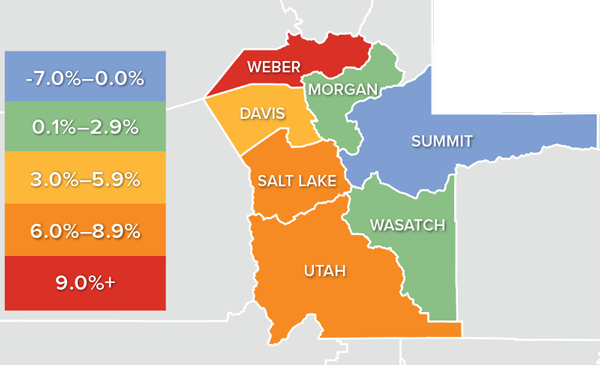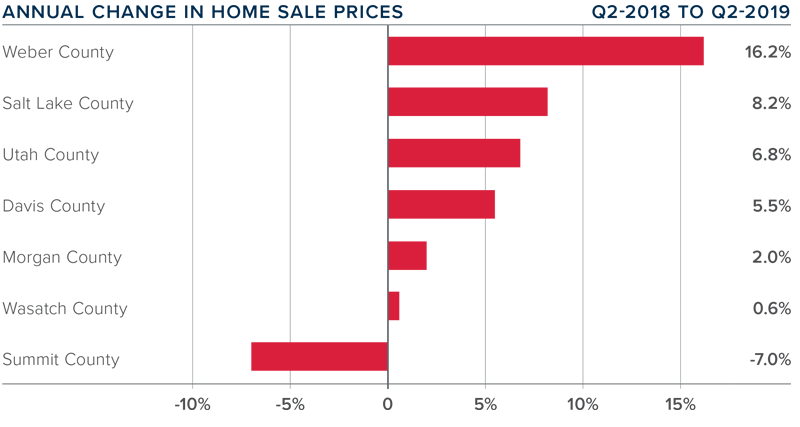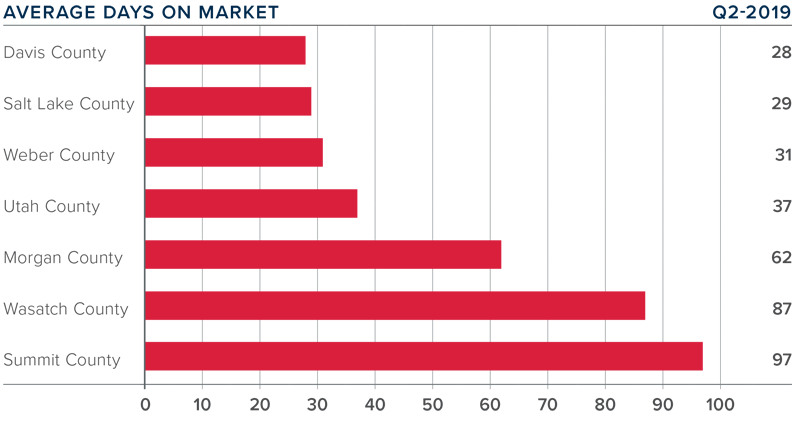The following analysis of select counties of the Utah real estate market is provided by Windermere Real Estate Chief Economist Matthew Gardner. We hope that this information may assist you with making better-informed real estate decisions. For further information about the housing market in your area, please don’t hesitate to contact your Windermere agent.
ECONOMIC OVERVIEW
Utah’s non-agricultural employment rose by 42,600 jobs over the past 12 months, representing a solid growth rate of 2.8%. For perspective, the U.S. growth rate is 1.5%. It is appropriate to note that the pace of growth has started to slow and that this is likely to continue given the maturity of the economic cycle. That said, I anticipate the state will see job growth of around 3% in 2019.
In May, the state unemployment rate was 2.9%, marginally below the 3.1% level seen a year ago.
HOME SALES
- 10,131 homes sold in the second quarter of 2019, representing an increase of 1.5% compared to the same period in 2018.
- Total sales activity rose in four counties contained in this report and fell in three, though the contraction was relatively small in the markets that historically see fewer sales.
- The number of homes for sale in the second quarter was 22.2% higher than in the same period a year ago and was 18.9% higher than the first quarter of the year. There continues to be significantly more choice in the market, which must be pleasing to home buyers.
- Pending sales in the second quarter were up 10.4% compared to a year ago, suggesting that closings in the third quarter are likely to be an improvement over the current numbers.

HOME PRICES
- The average home price in the region continued to rise in the second quarter, with a year-over-year increase of 6.1% to an average of $391,914.
- All but Summit County saw price increases compared to the same period a year ago. The drop in prices in Summit County was significant but, because it is a small and expensive area, I am not overly concerned this represents a pervasive trend.
- Appreciation was strongest in Weber County. Prices there rose 16.2% to $297,000. As the most affordable market in the area, this is not surprising.
- The takeaway here is that home prices continue to appreciate at quite significant rates. I expect to see some moderation in price growth, but the region will continue to outperform the nation as a whole.

DAYS ON MARKET
- The average number of days it took to sell a home in the counties covered by this report rose 13 days compared to the second quarter of 2018.
- Homes sold fastest in Davis and Salt Lake counties and slowest in the pricey Summit County. All counties saw days-on-market rise compared to the second quarter of 2018.
- During the second quarter of this year, it took an average of 53 days to sell a home in the region, down from the 65 days it took in the first quarter.
- The regional economy continues to outperform the U.S. as a whole, and this continues to drive housing demand. Inventory levels have risen, and this gives buyers more choice, which will lead to market time rising.

CONCLUSIONS
 This speedometer reflects the state of the region’s real estate market using housing inventory, price gains, home sales, interest rates, and larger economic factors.
This speedometer reflects the state of the region’s real estate market using housing inventory, price gains, home sales, interest rates, and larger economic factors.
For the second quarter of 2019, I have left the needle at the same position as last quarter. While inventory levels are rising, this year will be another good one for home sellers. Furthermore, mortgage rates remain quite low which will result in home prices continuing to rise.
ABOUT MATTHEW GARDNER
 As Chief Economist for Windermere Real Estate, Matthew Gardner is responsible for analyzing and interpreting economic data and its impact on the real estate market on both a local and national level. Matthew has over 30 years of professional experience both in the U.S. and U.K.
As Chief Economist for Windermere Real Estate, Matthew Gardner is responsible for analyzing and interpreting economic data and its impact on the real estate market on both a local and national level. Matthew has over 30 years of professional experience both in the U.S. and U.K.
In addition to his day-to-day responsibilities, Matthew sits on the Washington State Governors Council of Economic Advisors; chairs the Board of Trustees at the Washington Center for Real Estate Research at the University of Washington; and is an Advisory Board Member at the Runstad Center for Real Estate Studies at the University of Washington where he also lectures in real estate economics.
 Facebook
Facebook
 X
X
 Pinterest
Pinterest
 Copy Link
Copy Link



